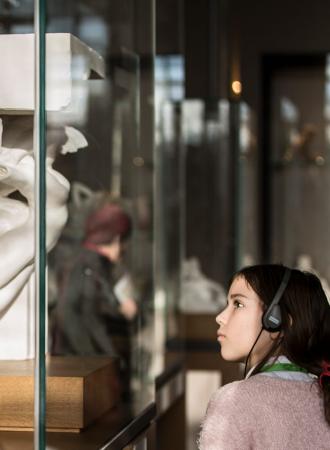Search the site
Camille Claudel comes out of the reserve collections
The Journey of a Woman Sculptor : Camille Claudel (1864-1943) student, assistant, mistress and muse… of Auguste Rodin
The events of my life would fill more than a novel. It would take an epic, the Iliad and the Odyssey, and a Homer to tell my story “I won't recount it today, I don't want to sadden you. I have fallen into an abyss. I live in a world so curious, so strange. Of the dream that was my life, this is the nightmare
Camille Claudel to Eugène Blot, Asile de Montdevergues
TIMELINE
A promising young artist
The eldest daughter of three children, Camille Claudel was born into a bourgeois family on the 8 December 1864, in a small village near Soissons.
Right from childhood, she felt the urge to model with clay, her artistic vocation having asserted itself very early on. Filled with enthusiasm, and resolved to pursue her vocation, she moved to Paris to enrol as a student at the Academy Colarossi.
Already, at the age of 18, she was being guided by the sculptor Alfred Boucher who, when obliged to return to Italy, asked Rodin to take over the instruction of Camille and the other girls who shared the studio with her.
From the outset, those close to Camille, including her brother the poet and writer Paul Claudel, witnessed her fiery temperament, her tendency to dominate, her caustic wit and, later, the terrifying violence of her strange, eccentric and provocative character, as well as her legendary, savage gift for mockery.
Vue de l'oeuvre
Encounter with Auguste Rodin
From 1882, when they first met, until 1892, when they parted, Camille Claudel and Auguste Rodin would enjoy neither peace nor stability.
The process of creating sculpture, a key element in their story, was not always easy: apprenticeship, frustrations, the search for expression, experiments in modelling, etc., but it was the source of an irresistible, deep complicity of spirit.
After a passionate love affair that lasted ten years, filled with harsh exchanges, hard work, misunderstandings and disappointments on both sides, Camille Claudel drew a line once and for all on their relationship, with the intention of devoting herself henceforth entirely to her own career.
Vue de l'oeuvre
Alone, and at the height of her artistic career
Once the love affair was over, Camille Claudel wished to free herself permanently from Rodin’s influence, which she considered too intrusive. In an effort to establish her own creative identity, and to break away completely from Rodin’s, she took a totally different direction in her research, experimenting with new intimist scenes, which until that point had been restricted to the field of painting.
With her new subjects, including Les Causeuses [The Gossips], which stands out among her most famous compositions, she captured and reproduced brief moments from everyday life.
At the height of her artistic career, she once again asserted her originality with La Vague [The Wave], a sculpture directly influenced by Hokusai and Japonism, and evoking the style of Art Nouveau. In both these works, the distinctive, complex treatment of the hair, the use of difficult materials like onyx marble, the sophisticated use of polychromy and the daring compositions… sustained her decided taste for virtuosity.
Vue de l'oeuvre
Her tragic descent towards 30 years of isolation
In spite of the manifestations of inner turmoil that began to appear, Camille Claudel continued to work and to exhibit until 1905. However, she was increasingly experiencing serious material and financial difficulties, whilst the onset of a latent persecution delirium was beginning to cause her distress. Her resentment towards Rodin exacerbated an already irreversible dementia, from which she was increasingly unable to recover. She was now approaching the age of fifty, and nothing remained of her legendary beauty.
One week after the death of her father, she was committed on 10 March 1913 to the Ville-Evrard mental asylum in the department of the Seine-et-Oise, then transferred to the psychiatric hospital at Montdevergues near Avignon.
There and then, without even attempting to fight against being put away and forgotten, she gave up sculpture.
She died alone on 19 October 1943 at the age of 79, after thirty years of enforced confinement.
Vue de l'oeuvre
Exhibition(s) location(s)
Musée Rodin
77, rue de Varenne, 75007, Paris
Dates
From October 1, 2013 to January 5, 2014








